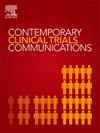Iron mother- protocol for a randomised controlled trial of daily versus alternate day ferrous fumarate for the treatment of iron deficiency anaemia in pregnancy
IF 1.4
Q4 MEDICINE, RESEARCH & EXPERIMENTAL
引用次数: 0
Abstract
Objective
Iron deficiency anaemia (IDA) is the commonest haematological problem in pregnancy and has implications for maternal, fetal, and childhood health. Treatment, despite being inexpensive and readily available, remains challenging with issues relating to compliance, tolerability, and effectiveness. There is a lack of consensus regarding the optimal dosing of oral iron replacement in pregnancy. Emerging evidence from non-pregnant populations suggest that alternate day dosing may be as effective.
Methods
We propose a phase IV open label randomised controlled non-inferiority trial of daily versus alternate day ferrous fumarate for a 4-week period for the treatment of confirmed iron deficiency anaemia in pregnancy. Our study population comprises singleton pregnancies between 14+0- and 34+0-weeks’ gestation with a haemoglobin (Hb) of <10.5g/dL and a ferritin of <30μg/L. The intervention is alternate day ferrous fumarate 305mg (100mg elemental iron) and the comparator is daily ferrous fumarate 305mg. The primary endpoint, change in Hb from randomisation to week 4, will be analysed by linear regression, adjusting for baseline Hb level. Analysis will be conducted by intention-to-treat analysis with per protocol sensitivity analysis. Sample size was calculated on the assumption of no difference between primary endpoint means, a Type 1 error rate of 0.025, a power of 90 %, a standard deviation of 0.83 g/dL and a non-inferiority margin of −0.4 g/dL. Under these assumptions, 92 subjects per treatment arm would be required to test for non-inferiority.
Conclusion
We hypothesise that alternate day iron in pregnancy will be as effective as daily iron for the treatment of iron deficiency anaemia.
求助全文
约1分钟内获得全文
求助全文
来源期刊

Contemporary Clinical Trials Communications
Pharmacology, Toxicology and Pharmaceutics-Pharmacology
CiteScore
2.70
自引率
6.70%
发文量
146
审稿时长
20 weeks
期刊介绍:
Contemporary Clinical Trials Communications is an international peer reviewed open access journal that publishes articles pertaining to all aspects of clinical trials, including, but not limited to, design, conduct, analysis, regulation and ethics. Manuscripts submitted should appeal to a readership drawn from a wide range of disciplines including medicine, life science, pharmaceutical science, biostatistics, epidemiology, computer science, management science, behavioral science, and bioethics. Contemporary Clinical Trials Communications is unique in that it is outside the confines of disease specifications, and it strives to increase the transparency of medical research and reduce publication bias by publishing scientifically valid original research findings irrespective of their perceived importance, significance or impact. Both randomized and non-randomized trials are within the scope of the Journal. Some common topics include trial design rationale and methods, operational methodologies and challenges, and positive and negative trial results. In addition to original research, the Journal also welcomes other types of communications including, but are not limited to, methodology reviews, perspectives and discussions. Through timely dissemination of advances in clinical trials, the goal of Contemporary Clinical Trials Communications is to serve as a platform to enhance the communication and collaboration within the global clinical trials community that ultimately advances this field of research for the benefit of patients.
 求助内容:
求助内容: 应助结果提醒方式:
应助结果提醒方式:


